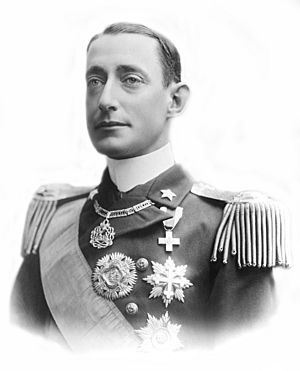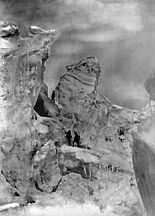Prince Luigi Amedeo, Duke of the Abruzzi facts for kids
Quick facts for kids Prince Luigi Amedeo |
|||||
|---|---|---|---|---|---|
| Infante of Spain | |||||
 |
|||||
| Duke of the Abruzzi | |||||
| Predecessor | New title | ||||
| Successor | Prince Amedeo Michele | ||||
| Born | 29 January 1873 Royal Palace of Madrid, Madrid, Spain |
||||
| Died | 18 March 1933 (aged 60) Villaggio Duca degli Abruzzi, Italian Somaliland |
||||
| Burial | Riverbank of the Shebelle River | ||||
|
|||||
| House | Savoy | ||||
| Father | Amadeo I of Spain | ||||
| Mother | Maria Vittoria dal Pozzo | ||||
| Religion | Roman Catholic | ||||
Prince Luigi Amedeo, Duke of the Abruzzi (born 29 January 1873 – died 18 March 1933) was an Italian explorer and mountaineer. He was also a member of the royal House of Savoy. This made him a cousin of the Italian King Victor Emmanuel III. He is famous for his trips to the Arctic and his mountain climbing adventures. These included Mount Saint Elias and K2. He also served as an Italian admiral during World War I. In his later years, he created a special village in Italian Somaliland.
Contents
Early Life and Royal Titles
Luigi Amedeo was born in Madrid, Spain. He was the third son of Prince Amadeo of Savoy, Duke of Aosta. His mother was Donna Maria Vittoria dal Pozzo. Luigi Amedeo was a grandson of King Vittorio Emanuele II of Italy. He was born when his father was briefly King of Spain.
His father, King Amadeo, gave up his throne in 1873. He then returned to Italy. Prince Luigi Amedeo was part of the House of Savoy, a very old royal family in Europe. His uncle became King Umberto I of Italy in 1878. His cousin became King Vittorio Emanuele III in 1900.
King Umberto I created the title Duke of the Abruzzi for Luigi Amedeo in 1890. This title referred to the Abruzzo region in central Italy. Before this, he was known as an Infante of Spain.
Early Travels and Mountain Training
From 1893 to 1896, Luigi Amedeo traveled around the world. He visited Eritrea, which was an Italian area back then. He also went to Vancouver. In 1893, he visited Italian Somaliland. He helped calm some unrest there. This was his first time in a land he would later love and where he would pass away.
He started training as a mountaineer in 1892. He climbed Mont Blanc and Monte Rosa in the Italian Alps. In 1897, he made the first climb of Mount Saint Elias (5,489 meters) in Canada/U.S. During this trip, the expedition looked for a strange sight. It was called the Silent City of Alaska. People said they saw it over a glacier. One member wrote that it looked so real, it was hard to believe it wasn't a city.
Arctic Expedition to the North Pole
In 1898, Prince Luigi Amedeo planned a trip to the North Pole. He talked to Fridtjof Nansen, a famous polar explorer. Nansen had sailed very far north before. In 1899, Amedeo bought a ship called Jason. It was a steam whaler. He renamed it Stella Polare (meaning "Pole Star"). He had it made stronger for ice travel.
In the spring of 1899, he arrived in Christiania (now Oslo, Norway). He had ten friends with him. The Stella Polare took them through the frozen sea. On June 12, they headed for Archangel in Russia.
On June 30, Stella Polare arrived in Arkhangelsk. The duke was welcomed by the governor. He also met local leaders and foreign visitors. A local newspaper wrote about a special play held for him. The Italian royal song was played.
The duke later wrote about his time in Arkhangelsk. He said they left on July 12. They went to church and then loaded their dogs onto the ship. The Stella Polare sailed out, with other ships guiding it.
Twenty men were part of the expedition. They included Captain Umberto Cagni. They planned to go to Franz Joseph Land in the Arctic. There, they would set up a camp for winter. After winter, they would try to reach the North Pole by dog sled.
Record-Breaking Journey
Prince Luigi Amedeo set up the winter camp on Rudolf Island. The expedition was supposed to start after the long Arctic night. But the duke lost two fingers because of the extreme cold. This meant he could not join the sled trip. He put Captain Cagni in charge of the journey to the pole.
On March 11, 1900, Cagni left the camp. On April 25, he reached latitude 86° 34’. This was a new record. It beat Nansen's record from 1895 by about 35 to 40 kilometers. Cagni barely made it back to the camp on June 23. On August 16, Stella Polare left Rudolf Island. The expedition returned to Norway. During the trip, they explored and mapped the northern coast of Rudolf Island and two other islands.
Later Adventures and Service
In 1906, the Duke led a trip to the Ruwenzori Range (5,125 meters) in Uganda. He climbed sixteen peaks there. This included the six main peaks. One of them, Mount Luigi di Savoia, is named after him. The highest peak was reached on June 18, 1906.

His next big trip was in 1909. He aimed to climb K2 in Karakoram. A team led by Prince Luigi Amedeo reached 6,250 meters on the mountain. The main path up K2 today is called the Abruzzi Spur.
He also tried to climb Chogolisa. He and his team did not reach the very top. But they set a world altitude record. They reached about 7,500 meters (24,600 feet). They turned back just 150 meters below the summit due to bad weather.
Luigi Amedeo was a vice-admiral in the Italian Royal Navy (Regia Marina). He was in charge of Torpedo Craft from 1911 to 1912. During World War I, he was the Commander-in-Chief of the Italian Fleet. This was from 1914 to 1917. His main ship was the Italian battleship Conte di Cavour. Under the duke, the Regia Marina helped save the Army of the Kingdom of Serbia. In February 1918, he was promoted to admiral.
The Explorers Club in New York made the duke an Honorary Member in 1912. This is their highest level of membership.
The duke also helped Italian leader Benito Mussolini with a treaty in 1928. This was the Italo-Ethiopian Treaty of 1928. He traveled to Addis Ababa with gifts. One gift was a Fiat 3000 tank. This tank later helped stop a planned takeover in 1928.
In 1932, the duke was briefly the president of the new Italian Line of steamships. This company brought together all of Italy's transatlantic shipping lines. But the duke resigned soon after a ship called SS Rex broke down. He said he could not get the leaders of the old companies to work together.
Developing Italian Somaliland
In 1918, the Duke went back to Italian Somaliland. In 1920, he started a farming village. It was called "Village of the Duke of Abruzzi" (Villaggio Duca degli Abruzzi or Villabruzzi). It was about 90 kilometers north of Mogadishu. This village was an experiment. They tried new ways of growing crops.
By 1926, the area had 16 villages. There were 3,000 Somali people and 200 Italian people living there. The Duke raised money for many projects in the town. These included roads, dams, schools, hospitals, a church, and a mosque.
He passed away in the village on March 18, 1933.
By the late 1930s, this village area was very developed. It was one of the most advanced farming areas in Somalia before World War II. It also had important food factories. After Italian Somaliland ended in 1947, the town was renamed Jowhar.
Personal Life
In the early 1900s, the Duke was in a relationship with Katherine Hallie "Kitty" Elkins. She was the daughter of a rich American senator. But his cousin, King Victor Emmanuel III of Italy, did not allow him to marry her. This was because she was not from a royal family.
Prince Luigi Amedeo never officially married. However, in his later years, he had a deep romantic partnership with Faduma Ali. She was a young Somali woman. She stayed by his side even when he was very ill.
Scientific Works
- La Stella Polare nel Mare Artico 1899-1900 (1902)
- On the "Pole Star" in the Arctic Sea (1903) by H.R.H. Luigi Amadeo of Savoy, (Duke of the Abruzzi), translated by William Le Queux, 2 vols.
- Osservazioni scientifiche, eseguite durante la spedizione polare di S.A.R. Luigi Amedeo di Savoia (1903, with Umberto Cagni and Cavalli-Molinelli)
Animal Named in Honor
A type of African lizard, Leptosiaphos aloysiisabaudiae, is named after Prince Luigi Amedeo.
Honours
| Styles of Prince Luigi Amedeo, Duke of the Abruzzi |
|
|---|---|
 |
|
| Reference style | His Royal Highness |
| Spoken style | Your Royal Highness |
 Kingdom of Italy:
Kingdom of Italy:
- Knight of the Supreme Order of the Most Holy Annunciation, 2 May 1893
- Knight Grand Cross of the Order of Saints Maurice and Lazarus, 2 May 1893
- Knight Grand Cross of the Order of the Crown of Italy, 2 May 1893
- Commander of the Military Order of Savoy, 16 March 1913; Grand Officer, 29 December 1916; Grand Cross, 7 February 1924
- Knight of the Civil Order of Savoy
 Sovereign Military Order of Malta: Knight of Honour and Devotion of the Military Order of Malta
Sovereign Military Order of Malta: Knight of Honour and Devotion of the Military Order of Malta Empire of Japan: Grand Cordon of the Order of the Chrysanthemum, 19 June 1895
Empire of Japan: Grand Cordon of the Order of the Chrysanthemum, 19 June 1895 United Kingdom:
United Kingdom:
- Honorary Knight Grand Cross of the Royal Victorian Order, 21 November 1899
- Founder's Medal, 1901
 Sweden: Knight of the Royal Order of the Seraphim, 11 September 1900
Sweden: Knight of the Royal Order of the Seraphim, 11 September 1900 United States: Cullum Geographical Medal, 1903
United States: Cullum Geographical Medal, 1903 Siam: Knight of the Most Illustrious Order of the Royal House of Chakri, 2 January 1904
Siam: Knight of the Most Illustrious Order of the Royal House of Chakri, 2 January 1904 Albania: Grand Cordon of the Order of the Black Eagle, 1914
Albania: Grand Cordon of the Order of the Black Eagle, 1914 Spain: Grand Cross of the Royal and Distinguished Order of Charles III, with Collar, 1928
Spain: Grand Cross of the Royal and Distinguished Order of Charles III, with Collar, 1928
See also
 In Spanish: Luis Amadeo de Saboya para niños
In Spanish: Luis Amadeo de Saboya para niños
- Picco Luigi Amedeo, a mountain in the Mont Blanc massif in the Val d'Aosta, Italy
- Savoia Peak, a peak at the northeast end of Sierra DuFief
- Luigi Island, an island in Franz Joseph Land
- Al Abraq, Libya, called by the Italians as Luigi di Savoia
- Duke of Abruzzi's Free-tailed Bat, a species of bat
- Abruzzi Secondary School, Shigar, Gilgit Baltistan
- Italian cruiser Luigi di Savoia Duca degli Abruzzi, an Italian cruiser



